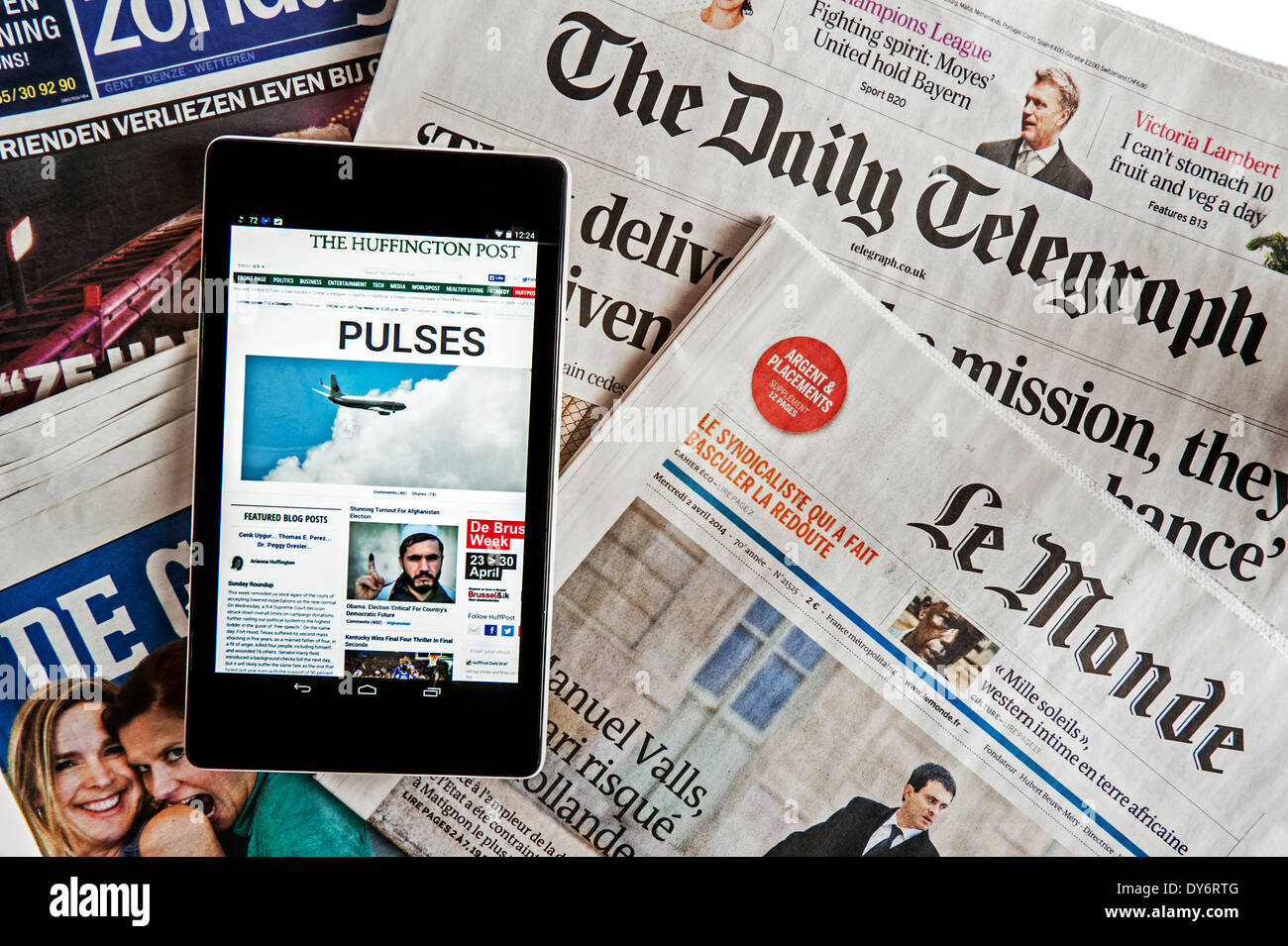The Effect of Social Media Site on the Way We Take In News Online
Social media has fundamentally transformed news intake. It offers prompt accessibility to information, frequently overshadowing standard media electrical outlets. Nonetheless, this quick dissemination comes with obstacles. Users face the threat of experiencing false information and ending up being trapped in echo chambers. The algorithms driving individualized web content can cover diverse viewpoints. As these characteristics progress, comprehending their ramifications becomes essential for notified interaction in public discourse. What techniques might aid browse this complicated landscape?
The Evolution of News Consumption in the Digital Age
As technology advanced, the way people taken in news changed substantially in the digital age (stnews.live). Conventional papers and broadcast media began to decline as the web became a primary resource of information. Online platforms used immediate access to newspaper article, video clips, and podcasts, enabling individuals to stay educated at any moment. The benefit of mobile phones additionally accelerated this change, allowing users to receive updates on the move
In addition, the surge of news collectors and websites helped with the usage of varied point of views, encouraging customers to customize their news intake based upon personal rate of interests. This advancement likewise triggered news companies to adjust their strategies, concentrating on electronic content and engaging visitors via multimedia layouts. Consequently, the standard obstacles of time and space in news shipment reduced, causing a more immediate and customized news experience for target markets worldwide.
The Function of Social Media Platforms in News Distribution
Social network systems have transformed news distribution by offering instant accessibility to information. Their algorithm-driven web content curation usually focuses on interaction over accuracy, causing considerable reliability difficulties (stnews.live). As users navigate this landscape, the implications for news consumption and public discourse become increasingly complex
Instantaneous News Accessibility
Although typical news electrical outlets have long been the primary source of details, the rise of social networks systems has actually significantly transformed just how news is accessed and eaten. Instantaneous news access has actually come to be a hallmark of the electronic age, allowing individuals to obtain updates in genuine time. Systems such as Twitter, Facebook, and Instagram permit news to spread out swiftly, often going beyond traditional media in rate and reach. Users can share tales, comment on occasions, and involve with journalists, producing a dynamic communication between the target market and news web content. This immediacy cultivates a society of urgency, motivating individuals to inquire quickly. As a result, the expectation for timely news has actually reshaped journalistic techniques, engaging news organizations to adjust their techniques to fulfill the needs of a hectic digital environment.
Algorithm-Driven Content
While individuals actively engage with web content on social media sites, the algorithms that govern these systems play a crucial role in figuring out which news tales gain exposure. These formulas examine customer habits, choices, and interaction metrics to curate customized news feeds. Consequently, specific tales may be magnified while others continue to be odd, typically prioritizing marvelous or trending subjects over substantive reporting. This selective direct exposure shapes customers' assumptions of present occasions and affects public discussion. The dependence on algorithm-driven content can produce resemble chambers, where users are mostly subjected to perspectives that line up with their very own ideas. The characteristics of news circulation on social media systems greatly influence just how people take in and interpret information in the digital age.
Integrity Obstacles
As users significantly transform to social networks for news, the integrity of information come across on these systems comes to be a pushing concern. The decentralized nature of social media sites permits anyone to publish content, often blurring the lines in between trustworthy journalism and misinformation. Algorithms prioritize engagement over precision, resulting in the widespread circulation of mind-blowing or deceptive stories. This setting presents significant obstacles for individuals attempting to discern credible resources. Social media platforms, while seeking to combat misinformation with fact-checking and web content moderation, run the gauntlet for inconsistencies and predispositions in their approaches. Eventually, the duty lies with customers to critically review the news they take in, as the quick spread of details often surpasses verification initiatives by platforms.
The Surge of Resident Journalism and User-Generated Web Content
The surge of resident journalism has actually encouraged everyday individuals to share news and point of views, usually supplying insights that standard media might forget. This change likewise presents considerable challenges, particularly the spread of misinformation that can develop from unverified content. As user-generated material comes to be a lot more widespread, the equilibrium in between authentic voices and precision in coverage remains a crucial worry.
Empowering Daily Voices

Challenges of Misinformation
While the increase of person journalism has opened up opportunities for diverse voices in the media landscape, it has actually also presented significant challenges associated with misinformation. The simplicity of sharing information through social media systems permits individuals to disseminate news swiftly, but this quick spread commonly comes at the cost of accuracy. User-generated web content often Recommended Site does not have the extensive fact-checking and content oversight that standard journalism supplies. Sensationalized or incorrect narratives can acquire traction, misdirecting audiences and shaping public perception. Furthermore, the blending of opinion and fact within social networks makes complex the difference in between reliable information and false information. Consequently, consumers need to navigate a significantly intricate media environment, needing essential assuming skills to discern reputable news sources among the sound

Misinformation and Its Ramifications for Public Discussion
As social media sites systems progressively control the landscape of details dissemination, the expansion of misinformation postures substantial challenges for public discussion. Misinformation, usually designed to deceive or provoke psychological reactions, can distort understandings of reality and threaten count on reputable resources. This sensation leads to polarized viewpoints, as individuals are attracted towards resemble chambers that reinforce their beliefs, further lodging departments within society.
The effects for public discussion are profound. When residents rely on false information, meaningful dialogue decreases, and the democratic process experiences. Misinformation can provoke concern and confusion, affecting public health and wellness, safety, and political security. As an outcome, promoting media proficiency comes to be crucial, equipping individuals to seriously assess information and discern fact from fiction. Dealing with the obstacles presented by misinformation is critical for protecting the honesty of public discourse and guaranteeing a well-informed populace efficient in involving in positive discussions.
The Impact of Algorithms on News Presence
Offered the central duty of formulas in figuring out content presence, their influence on news intake is extensive. These algorithms, utilized by social networks platforms, focus on particular kinds of web content based upon user involvement and preferences. As a result, news posts that align with popular trends or target market passions are more probable to be shown plainly, while much less sensational stories might be ignored. This develops an environment where individuals are subjected largely to details that reinforces their perspectives, possibly leading to resemble chambers.
The consistent development of algorithms implies that news companies must adapt their methods to align with these altering specifications, commonly prioritizing clickbait or mentally billed headlines. The stability of news reporting can be endangered, as vital tales may not get the presence they are entitled to. The mathematical shaping try here of news visibility therefore plays a necessary function in affecting public assumption and understanding of existing occasions.
The Shift Towards Aesthetic Narration in News Media
Increasingly, news media is accepting visual narration as a powerful tool to engage audiences. This approach leverages photos, videos, infographics, and interactive aspects to share details better than typical text-based styles. As focus covers reduce, visuals offer a fast, impactful way to communicate intricate tales and grab viewers' interest.
Platforms like Instagram and TikTok have further accelerated this fad, compelling news companies to adjust their web content techniques to fit these visually-driven atmospheres. By incorporating engaging visuals, news site web outlets can boost psychological connections and foster greater understanding of topical problems.
Additionally, aesthetic narration permits for more diverse narratives, showcasing multiple perspectives via dynamic discussions. As target markets progressively take in news via mobile phones, the shift toward visuals not only satisfies user choices yet additionally assists to damage down obstacles to details accessibility. Inevitably, this development shows a broader improvement in how news is produced and consumed in the digital age.
Future Patterns: Browsing the Changing Landscape of News Intake
While the digital landscape remains to progress, news consumption is poised for significant makeover driven by emerging technologies and transforming audience habits. As expert system and maker knowing development, personalized news feeds will come to be more common, permitting users to get content customized to their interests. This personalization can cause greater interaction but also elevate worries about resemble chambers and false information.
Furthermore, the increase of voice-activated tools and wise audio speakers will affect just how news is supplied, moving the emphasis from visual to auditory formats. This trend might encourage wire service to embrace more succinct and appealing audio web content.

Frequently Asked Inquiries
How Do Social Media Site Interactions Affect News Reliability?
Social media site communications can substantially affect assumptions of news reliability. Engagement metrics, such as likes and shares, typically form target market depend on, with popular messages acquiring viewed legitimacy, despite the accuracy or integrity of the information provided.
What Function Do Influencers Play in Shaping News Narratives?
Influencers substantially form news narratives by leveraging their systems to amplify particular stories, commonly tailoring material to their target market. This can bring about prejudiced viewpoints, influencing public perception and prioritizing sensationalism over accurate coverage.
How Can Users Identify Reliable News Resources on Social Media?
Customers can recognize trustworthy news sources on social media by checking the resource's reliability, validating truths via multiple outlets, examining the professionalism and trust of the content, and recognizing potential biases in reporting to ensure accurate details.
What Effect Does Social Media Site Have on Typical Journalism Jobs?
Social media substantially influences standard journalism jobs by modifying profits designs, lowering demand for print media, and promoting competitors from resident reporters. Many specialists encounter task instability and need to adjust to rapidly changing media landscapes.
How Do Various Demographics Consume News on Social Media Site?
Various demographics exhibit diverse preferences for news consumption on social networks. More youthful audiences favor systems like TikTok and Instagram for fast updates, while older individuals often tend to prefer Twitter and facebook for much more extensive conversations and write-ups.